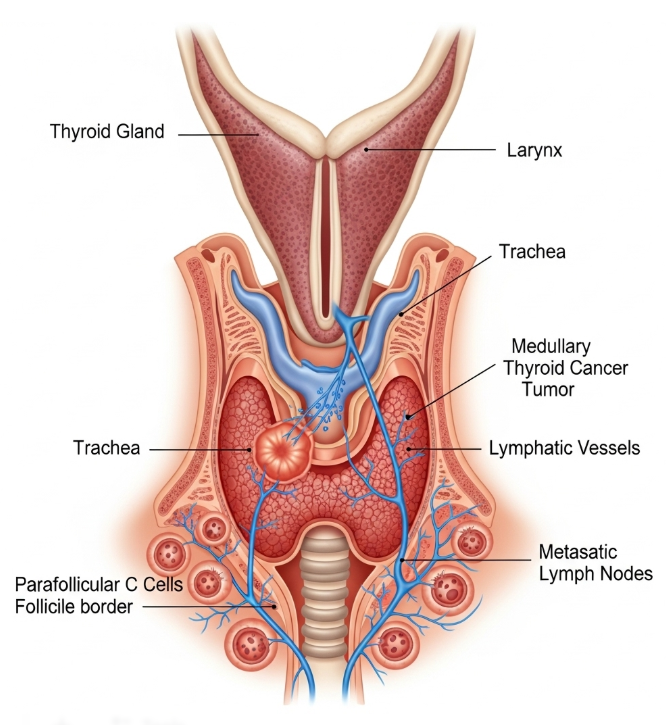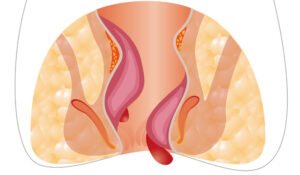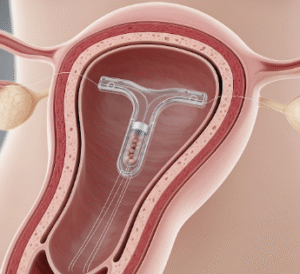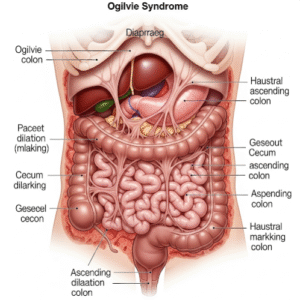Overview
Medullary thyroid cancer (MTC) is a rare type of thyroid cancer that originates from the parafollicular C-cells of the thyroid gland, which produce the hormone calcitonin. Unlike the more common papillary and follicular thyroid cancers, MTC is often more aggressive and can spread to the lymph nodes, liver, lungs, or bones. It accounts for about 3–5% of all thyroid cancers worldwide. In Korea, where thyroid cancer screening is highly advanced, medullary thyroid cancer is detected earlier, and patients benefit from specialized endocrine oncology centers offering precise diagnosis, genetic testing, and cutting-edge treatments.
What is Medullary Thyroid Cancer?
Medullary thyroid cancer is a neuroendocrine tumor of the thyroid gland. It can occur sporadically or be inherited as part of genetic syndromes such as Multiple Endocrine Neoplasia type 2 (MEN2A and MEN2B). Elevated calcitonin and carcinoembryonic antigen (CEA) levels are key markers used in diagnosis and monitoring.
Symptoms
- Neck lump or swelling
- Hoarseness or voice changes
- Difficulty swallowing (dysphagia)
- Persistent cough
- Enlarged lymph nodes
- Diarrhea or flushing (due to hormone secretion in advanced cases)
Causes
- Genetic mutations in the RET proto-oncogene (inherited or sporadic)
- Family history of medullary thyroid cancer or MEN syndromes
- Sporadic mutations in thyroid C-cells
Risk Factors
- Family history of MTC or MEN2 syndrome
- Inherited RET mutations
- Female gender (slightly higher incidence)
- History of other thyroid conditions
Complications
- Metastasis to lymph nodes, lungs, liver, or bones
- Hormone-related symptoms (diarrhea, flushing)
- Vocal cord paralysis after surgery if the recurrent laryngeal nerve is affected
- Reduced quality of life due to recurrence or advanced disease
Prevention
- Genetic counseling and testing for RET mutations in at-risk families
- Prophylactic thyroidectomy in children with high-risk RET mutations (standard in Korea’s top hospitals)
- Regular blood tests for calcitonin and CEA levels in at-risk individuals
Treatment Options in Korea
Diagnosis
- Blood tests: Calcitonin and CEA
- Ultrasound: Neck imaging for nodules and lymph nodes
- Fine needle aspiration (FNA) biopsy with calcitonin washout
- Genetic testing for RET mutations
- CT, MRI, or PET-CT for staging and metastasis detection
Medical Treatments
- Targeted therapies (tyrosine kinase inhibitors such as vandetanib, cabozantinib)
- Symptom control (e.g., medications for diarrhea and flushing)
- Hormonal monitoring with calcitonin and CEA
Surgical or Advanced Therapies
- Total thyroidectomy with central lymph node dissection (gold standard)
- Prophylactic thyroidectomy in RET-positive carriers (children and young adults)
- Advanced robotic or minimally invasive thyroid surgery in Korea’s specialized centers
- Radiotherapy and systemic targeted therapy for advanced cases
Rehabilitation and Support
- Lifelong thyroid hormone replacement therapy after thyroid removal
- Regular follow-up with calcitonin and CEA levels
- Genetic counseling for family members
- Psychological and nutritional support for long-term management













